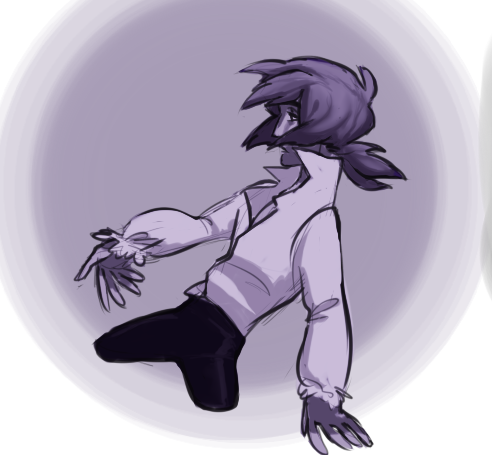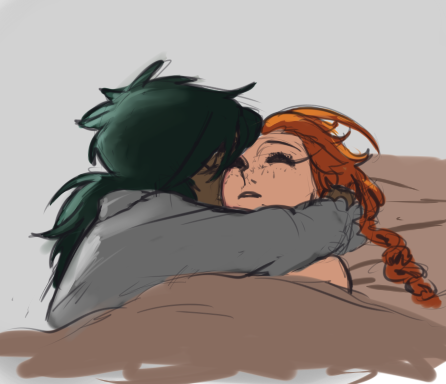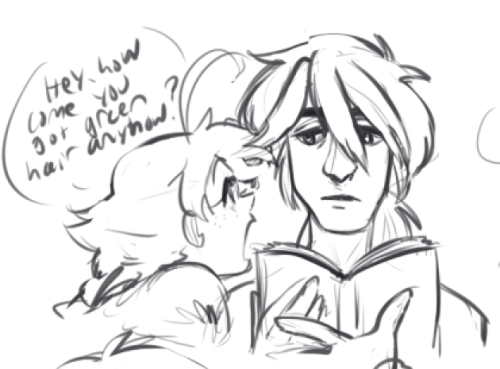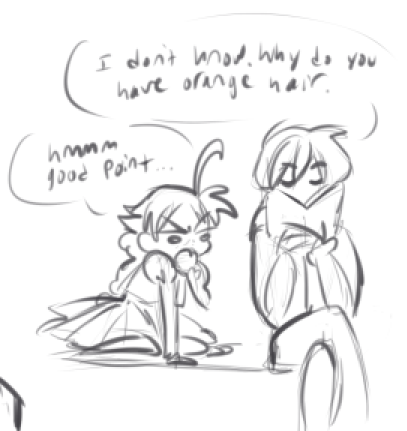Experience Tumblr Like Never Before
Princess Tutu - Blog Posts
Princess Tutu and Grand Narrative

Once upon a time, there was a clumsy school girl granted the power to transform into the magical ballerina Princess Tutu.
“Once upon a time” is a familiar phrase used to connect stories that take place in lands distant and times different from one another into the same fairytale world. Each episode of the anime Princess Tutu begins with this familiar phrase and then proceeds to tell a story both known and new, where Hans Christian Anderson’s Ugly Ducking becomes Odette, the Swan Queen, from Swan Lake, thanks to the magic of the mysterious Drosselmeyer, who bares a striking resemblance to the character of the same name from The Nutcracker. Princess Tutu is not just a retelling of a handful of fairy tales, it’s an adaptation of stories across literature, ballet, opera, and of course, anime. Each piece of Princess Tutu’s narrative belongs to worlds larger than its own. The series challenges paradigms about typical narrative creation by weaving together multiple “grand narratives”.
While working as an editor for Kadokawa Shoten in the late 80s, Otsuka Eiji wrote a paper called “World and Variation: The Reproduction and Consumption of Narrative” in which he explains the idea of the grand narrative. An individual story only gives the audience a small glimpse into that wider world that the story is set in. This wider world is full of countless narratives told from countless perspectives that make up the grand narrative. Eiji uses the Gundam franchise to illustrate this concept where any given episode of the anime is a small snapshot of narrative within the larger universe(s) Gundam takes place in. Eiji explains, “Countless other [stories] could exist if someone else were the main character.”
Everyone is the main character of their own story. But most of these stories that make up the grand narrative of a world are hidden from view. It’s impossible to tell every story at once and have it be comprehensible. Instead we can only consume small bite-sized narratives that give us a snapshot of the (hopefully) interesting parts of a protagonist’s life. But who, exactly, is controlling these smaller narratives? This is a question faced by the characters of Princess Tutu.
The concept of shifting protagonists and expanding the audience’s view into the grand narrative heavily ties into Princess Tutu’s premise. The anime’s story is catalyzed by Drosselmeyer, the author of a fictitious book called The Prince and The Raven. The book’s ending is a stalemate between the titular characters so Drosselmeyer decides to promote the minor character of Princess Tutu to the role of main character to help the story move forward.
As you can probably tell by the name, Princess Tutu is heavily influenced by ballet. One of the show’s more significant influences is Swan Lake. Through the anime’s re-purposing of Swan Lake’s Odette as a magical girl, Princess Tutu continues to uphold ballet’s tradition of adapting the story for its own purposes.

Princess Tutu and Odette
The basic story of Swan Lake is about a prince falling in love with a girl cursed to be a swan from sunrise to sunset by an evil sorcerer. The sorcerer tricks the prince into confessing his love for his daughter, Odile, instead of the swan girl thus dooming the swan girl’s chance at true love and breaking the curse.
Amanda Kennell, an American scholar, outlines in her paper “Origin and Ownership from Ballet to Anime” Swan Lake’s production history and the evolution of the ballet’s narrative. The original staging in 1877 had the story end with the villain going unpunished and the two lovers drowning in a flood. In a revival staging from 1895 the villain was defeated and the two lovers reunited in heaven after throwing themselves into a lake. In a single scene production called The Magic Swan from the 1940s, the iconic “black swan” was introduced setting the precedent for the same ballerina to play the role of Odette and Odile in striking white and black costumes. And finally, another staging in 2006, not only adopted the White and Black Swan motif, but also changed the ending once again so that the prince kills the villain and he and Odette live happily ever after.
Despite each staging of the classic having significant differences, none of the variations are cast away as counterfeits. The value of the production isn’t in how close it is to the original Swan Lake but instead in the relative merit of each variation. In fact, it doesn’t really matter which you consider “the original” where the additions made by each carry their own merit and add to Swan Lake’s grand narrative. In this same regard, it would be acceptable to consider Princess Tutu another variation on the world of Swan Lake’s grand narrative.
There is terminology for this phenomenon in Kabuki theater. Eiji points out in his paper the similarities between the concepts of Sekai (world) and Shukou (plot) from Kabuki theater and his ideas of the grand narrative and the smaller narratives.
In Kabuki, Sekai represents the world a story takes place in and Shukou represents the story that is a product of that world. Each staging of a Kabuki play is its own Shukou derived from either a single Sekai or the mixing of Sekai. What matters in creating a good performance is not necessarily conveying the Sekai but instead the relative merit of the Shukou’s take on things. No performance is exactly the same and different actors bring different strengths to a performance and in turn provide a different experience for the audience’s entertainment. This of course carries over to more art forms than just Kabuki, classic ballet is in a similar position where entire songs are sometimes re-choreographed just to match the strengths of an individual ballerina. Ballet in particular has a long tradition of making minor and major changes to suit an individual performance. Whether it be tweaking choreography or straight up giving the story a different ending. The evolution of Swan Lake’s production is an excellent example of how productions of what are considered to be the same story can dramatically vary.
But Princess Tutu borrows from more stories than just Swan Lake. This brings us back to Kabuki and the idea of mixing Sekai in order to create another Shukou.
Princess Tutu takes pieces of classic stories and rearranges them to create something simultaneously familiar and completely new. Princess Tutu is not forging a new Shukou from only Swan Lake’s Sekai, but instead is connecting the canon of European literature and performing arts together into an even more extensive grand narrative.
Just look at the series’ opening for example, where Swan Lake and The Nutcracker are intertwined with one another as the anime’s titular character is dressed in the ballet costume of Odette and dances to The Nutcracker’s Flower Waltz to simultaneously combine the worlds of two ballets while producing an entirely new moment unique to the Princess Tutu anime.
The anime ends on the implication that if one person tries to control a story and the grand narrative it’s connected to, that person will fail. Princess Tutu is an excellent reminder of how stories are dynamic. Stories end up taking on a life of their own evolving, expanding and being reworked by both creators and consumers.
Eiji explains that once the consumers feel they have a grasp on the grand narrative they are free to produce their own small narratives from it. This is exactly how its creators forged Princess Tutu from the grand narrative of classic literature and performing arts. Just as mangaka can’t help it if a doujinshi adds to the narrative of their original story, Travosky can’t control the new life his ballets have taken on in Princess Tutu. Stories will take on a life of their own, abandon the need for an original and become a part to a larger grand narrative to be consumed and reworked over and over.
This is such an awesome analysis!
How to use in-betweens and arcs: A study of Rue and Duck’s pas-de-deux in “Princess Tutu”
This is based on a little talk I gave to students during a one-week animation crash course at Cambridge a few months ago. The project was to create a character and animate it performing a simple looping dance. I first briefed them on the very beginnings of the process, looking at reference and collecting research materials to inform their creative choices, and explained and demonstrated the basic tools they needed to use, including keyframing, in-betweening, and timing. Then I showed them this clip from Princess Tutu on the morning before they actually started drawing their animations.
I used this bit in particular because I thought it was a really accessible way to demonstrate a key difference between communicating with moving image compared to still image. While many of the same principles apply (in particular, to your keyframes, which I’d already done my best to drum into them), the in-betweens can carry a lot of weight and really change how the action reads.
Keep reading


started watching princess tutu in nov and im sooo obsessed with duck


The second ballet piece for Fakir/Ahiru is “The Nutcracker”(“Der Nussknacker” in German) which, through a few iterations, was based on German author E. T. A. Hoffmann’s story, “The Nutcracker and the Mouse King”.
The Princess Tutu character of Drosselmeyer was also inspired by the character of the same name from “The Nutcracker”, and many of the musical pieces feature in the anime. As a much-loved story about a plucky girl and a courageous swordsman who is more than meets the eye, it was only fitting that this ballet is a perfect fit for this pairing.


I’ve wanted to do a mini ballet inspired Princess Tutu fanart series, but this got put on hiatus when my dad got sick last year. I’m now finally getting around to it, and first up is none other than “Romeo and Juliet”, or to use its Italian title (the play does take place in Verona, Italy), “Romeo e Giulietta”.
The background silhouette is inspired by the art of Junichi Nakamura, who in turn inspired the use of silhouettes in shoujo anime such as Utena. The scene depicted in the background is the famous balcony scene, while the foreground is one familiar to PT fans: The Last Farewell. I tried to make the mood reminiscent of the lovers sharing one last late night pas de deux before they must part ways. Hopefully I managed to capture the angst in that scene 🤧
EDIT: added a close up cus I realized their faces are really small in the full size image and it’s hard to see the angst unless you zoom in 😂

Mythos has the worst hair of all of them let's be honest
Me minding my own business, drawing Fakir as a tree
My Brain: Make it an oak tree
Me looking at all the leaves I have to draw
Me: Absolutely not.


Ahiru loves pineapple on pizza and she could never prepare herself for the look of utter disgust on Fakir’s face when he learns this fact

that story about the swan and the knight? haven’t heard that one in a while
Don’t mind me! This is just a comparison between two of my princess tutu pieces cause I’ve got some reminiscing and pontificating in my system. ^.^
Keep reading

Princess Kraehe(Princess Tutu) | mussum

Fakiru Week: Violet
Dang this is intense






Im frustrated and my mouth hurts so I drew some medicine :V

I am so sorry. Mom's been watching Princess Tutu with me and this was her season one comment.

WIP:
Looky :D I'm making something. XD
Also,I gave Duck a yellow bathing suit for proprieties sake. I have no idea what i'm going to give her, if anything at all. :/

Bonus Picture
I couldn't get Fakir's face to work in the beginning, so........





A crossover between Portal and Princess Tutu. This was fun! Maybe clean up later?.....Maybe.
3 More Princess Tutu Head Cannons!
Cause what else am I supposed to do with my time?
1. The Final Heart Shard is not one of Mytho's emotions

Okay, this one will take a bit of backtracking.
In the story of the "Prinze und Raben" the knight is killed by the raven. When Fakir takes over the role of the knight, the events of the story are expected to be repeated; therefore, he is fated to die. Likewise, Princess Tutu confessed her love and vanished into a speck of light in the story, so when she shows up again, she is expected to repeat history.
You still with me? Okay good.
Fakir was told that he was the reincarnation of Mytho's protector, and that's how Drosselmeyer brought the role of the knight back into the story. But what about Tutu? Tutu vanished, but Drosselmeyer didn't try to convince Duck that she was a reincarnation. Instead, he gave a piece of Mytho's heart. Why?? Can a shard of emotion from the Prince turn her into a different person?
Maybe. But What if....Whaaat if, when Princess Tutu had confessed her love to Mytho in the story, he had absorbed her essence? What if Tutu had confessed on purpose so that she could give her power to Mytho? What if she became apart of his heart so that he could better fight against the Raven?

Also, remember that Mytho can only use his pink petal powers of awesomeness after Duck returns the final shard. The same powers that Tutu can be seen using in the first episode.
I propose that the heart shard Duck possesses can turn her into Princess Tutu because it was originally of Princess Tutu.
2. Rue doesn't know how to write.
(Whoops, Headlessknight totally debunked this one! Brought up the fact that Rue can be seen reading, and writes an essay so...my bad)
This one only really matters if you also subscribe to the head cannon that Fakir and Rue are siblings (and therefore Rue has story spinner abilities), which is explained and supported very well right here --->http://princesstutu.livejournal.com/209541.html

So! What do you do when you're trying to prevent your decedents from developing their reality warping writing powers and derailing your control over Kinkan town? Why, you traumatize one of them, and then (because you're a magnificently creative jerk) you prevent the other one from ever learning how to write in the first place!
Rue was kidnapped at a young age. Its highly unlikely that the Raven would have wanted to teach her how to read or write. In fact, the opposite is much more plausible. Preventing Rue from learning how to read and write would handicap her compared to the other children, and would undermine her self confidence. The Raven would likely use it as a way of holding power over Rue.
Even if she was taught how to write at Kinkan's school, she was primarily there for ballet, and I don't imagine any of her classes would foster the flames of creative writing. (Granted, I don't know this for sure... Can anyone elaborate on what the education of a dance academy in Germany would be like???)
3. Duck uses Fakir's hair as a nest/pillow.
Fakir's hair is super-duper fluffy; therefore, after the story has ended, Duck uses Fakir's hair as a nest and later pillow.
This head cannon has no rhyme or reason. I just like the idea of it.

Anywho, Thanks Guys and TTFN til next time :)
Psh I know that it's practically insulting that I post a Halloween video in February, but.... That's not gonna stop me anyway!
Princess Tutu Genderflip
So there's a gender bender Contest going on for Princess Tutu, also, there's a bit of a genderbend thing going around on tumblr. I drew some things, Just thought I might share :)


Hope you guys like um :D
2 Things I Appreciate about Princess TuTu
1. It's Respect towards Ballet

Barring that first episode, the main focus of the ballet is not as a gimmick.
Dance is an art form and a style of communication. As my theatre teacher once said, "When words aren't enough, you sing. When singing isn't enough, you dance. And when dancing isn't enough, you sing and dance together."
Throughout the show, the "fight scenes" are a "war" of ideas, and ballet is used as a conduit and punctuation for said ideas.
The ballet is used for expression, and while magical elements do occur (for example, Tutu dancing on top of water, or practically flying, or growing plants instantaneously. (which isn't totally uncalled for given that it's taking place inside a story)) the ballet puts the characters thoughts, feelings, and beliefs center stage.
2. The Character Development

Okay, confession time.
When I was first watching Princess Tutu, THIS guy made me really upset. I stuck around for a few episodes because I wanted to see Duck and Mytho end up together, but THIS GUY. EUUUGH......
I didn't hate him (To quote Swoozie, "My gang would never let me be a hater"), but I did dislike him to an extreme degree. Like, I loathed him. So I just quit watching the show and decided that I would look at some fanart to satisfy my desire for Mytho/Duck cuteness, except.......
All y'alls just had Fakir/Duck drawings everywhere, and to be honest, I thought you guys were crazy.
So I just swore off Princess Tutu, until one day I decided to give it another go.
And let me tell you....
I was not disappointed.
All four of the main characters grow in some way or another. THAT guy pictured above, went from being my most disliked fictional character to my most favorite fictional character.
The Heroine grows
The Villain-ess grows
The Jerk grows
The Prince grows
And all in ways that, to me, felt very satisfying and natural. I may be remembering this show through rose tinted glasses, but these characters were very human.

Even if one of them was technically a duck.
I am majorly impressed by the edits in this video. It's just so pretty!
3 Princess Tutu Headcannons
Mytho Used to be Blonde

In episode 5 we see a picture of an old man telling a boy (that we can assume to be Mytho because the print on the previous page mentions "the Prince" talking to an old man) about Princess Tutu. In the picture, the boy's hair is colored a faint yellow.

Also, if we look at Mythos eyebrows (yes, I am referencing his eyebrows) we can see that they appear to be a very pale brown.
Mytho 's hair was probably blonde ( maybe turned sandy brown as he grew up), and then after fighting decades with the raven, his hair turned white from old age. even though he never grew older in any other way.
Drosselmeyer Used to be Married to a Ballerina

Drosselmeyer had children; therefore, we'll assume that he was married. His wife died before him, and he was devastated. To help cope with the sadness, he started writing the "Prinz und Raben" and had used ballet in the story to honor her.
Duck is a Duckling and Not Native to Germany

Most (if not all) ducks, that start off yellow, later lose their downy feathers and grow new ones with different colors. Duck probably still has her downy and is therefore still quite young ( either that or it's an artistic choice.)
Also, no duck's native to Germany have pure yellow feathers as ducklings. (that I could find) Likely, Duck was brought in by a foreign family and lost. This would also explain her lack of knowledge of the towns history, and her surprise at seeing Mr. Cat. If she had grown up outside of Kinkan Town, she would not be used to the world warping weirdness of Drosselmeyer's powers.
Anywhoosies, I hope you like my headcanons and a good day everyone!



















